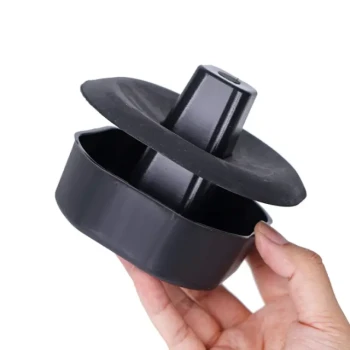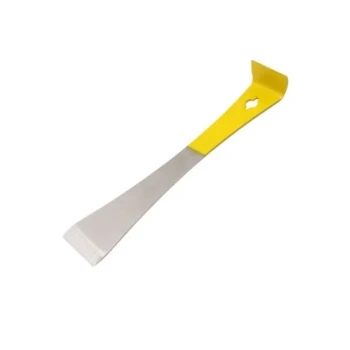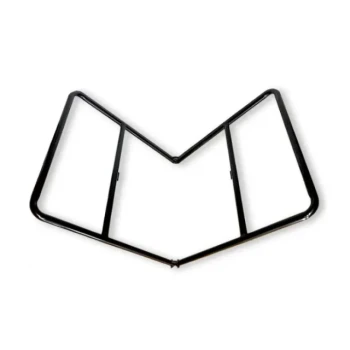Yes, a roof is an absolutely essential component of any modern beehive. It serves as the primary line of defense against weather, protecting the colony from rain, snow, and extreme sun. Without a proper roof or lid, a colony's ability to regulate its internal environment would be severely compromised, putting it at high risk.
A beehive roof is not just a simple lid; it is a critical climate control system. Its primary jobs are to keep the colony dry and to help the bees regulate internal temperature and humidity, which are fundamental to their survival and productivity.
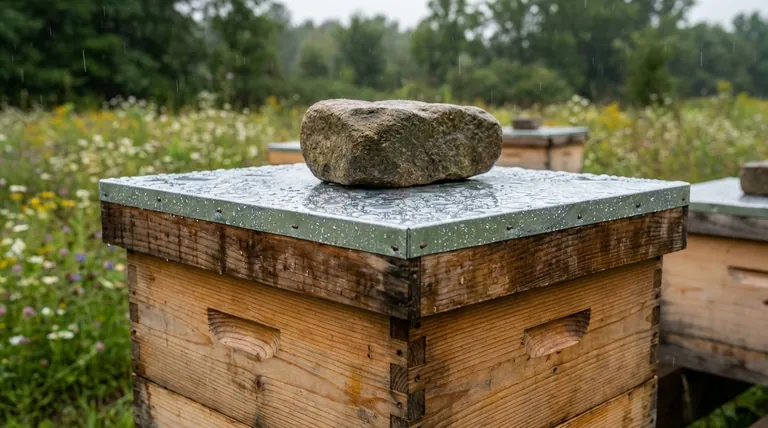
The Essential Functions of a Hive Roof
A hive roof, often working in tandem with an inner cover, performs several critical jobs that go far beyond simply keeping rain out.
Shielding from Precipitation
Moisture is one of the greatest threats to a honey bee colony. A waterproof roof prevents rain and melting snow from seeping into the hive, which can chill the brood, promote mold and disease, and spoil stored honey.
Regulating Internal Temperature
In the summer, a roof blocks direct sunlight, preventing the hive from overheating and forcing the bees to expend excess energy fanning to cool the interior. In the winter, it helps contain the heat generated by the winter cluster, reducing resource consumption.
Providing Critical Ventilation
Proper ventilation is crucial for managing humidity. A well-designed roof system allows warm, moist air generated by the bees to escape. This prevents condensation from forming and dripping down onto the bees—a situation that can be lethal during the cold winter months.
Enhancing Physical Security
A solid, weighted roof helps secure the hive components, preventing them from being shifted by high winds or knocked over by animals. It is common practice for beekeepers to place a heavy rock or brick on top to ensure it stays in place.
Common Hive Cover Setups
While the principle is the same, you will encounter a few common designs, each with a specific purpose.
The Standard Two-Part System
Most common Langstroth hives use a two-part system: an inner cover and a telescoping outer cover. The inner cover provides a dead air space for insulation and often has a small notch for an upper entrance or ventilation. The telescoping cover (the "roof") fits over the top and hangs down over the sides of the top hive box, offering superior protection from driving rain.
The Migratory Lid
A migratory lid is a simpler, single-piece cover that sits flush with the sides of the hive body. Its primary advantage is that it allows hives to be stacked tightly together on pallets for commercial pollination, but it offers less weather protection than a telescoping cover.
Ventilated and Gabled Roofs
Some manufacturers offer specialized roofs, such as gabled or ventilated models. These are designed to create additional space and airflow above the inner cover, more effectively venting hot air and moisture, which is especially beneficial in very hot or humid climates.
Understanding the Trade-offs
Choosing a roof involves considering material, design, and your local climate.
Material Matters: Wood vs. Metal Cladding
Most telescoping covers are made of wood and clad in a protective layer of aluminum. The metal provides excellent durability and water resistance. However, it can also absorb significant heat from the sun, making the insulation and ventilation provided by an inner cover even more important.
The Critical Risk of Poor Ventilation
A sealed-off, unventilated roof is a major liability. Trapped moisture is the primary danger, leading to condensation in the winter and high humidity in the summer. Always ensure your hive setup allows for adequate airflow.
Weight and Security
A lightweight cover is prone to being dislodged by wind or pests. Always ensure your roof fits snugly and is heavy enough, or is weighted down, to remain secure in all conditions.
Selecting the Right Roof for Your Hive
Your choice should be guided by your climate, hive type, and beekeeping goals.
- If you are a beginner with a standard hive: Start with the industry-standard telescoping cover and inner cover. It is a proven, reliable system that provides excellent protection in most climates.
- If you live in a very hot or humid climate: Consider investing in a ventilated or gabled roof to give your colony an advantage in managing heat and humidity.
- If your primary focus is ease of transport: A migratory lid is functional, but be mindful of its reduced weather protection and ensure it is properly secured.
Ultimately, treating the hive roof as an essential piece of climate-control equipment is the first step toward maintaining a thriving, resilient colony.
Summary Table:
| Function | Benefit |
|---|---|
| Weather Protection | Shields hive from rain, snow, and sun. |
| Temperature Regulation | Prevents overheating in summer and retains heat in winter. |
| Ventilation | Manages humidity to prevent condensation and disease. |
| Physical Security | Secures hive components against wind and animals. |
| Common Types | Telescoping Cover, Migratory Lid, Ventilated/Gabled Roofs. |
Equip Your Apiary for Success with HONESTBEE
A properly designed roof is fundamental to your hive's health and honey production. At HONESTBEE, we supply durable, weather-resistant beehive roofs and complete hive systems designed for the demanding needs of commercial apiaries and beekeeping equipment distributors.
Our wholesale-focused operations ensure you get the high-quality equipment your business depends on, at competitive prices.
Ready to protect your investment and boost your colony's resilience? Contact our expert team today to discuss your wholesale supply needs and discover the HONESTBEE difference.
Visual Guide
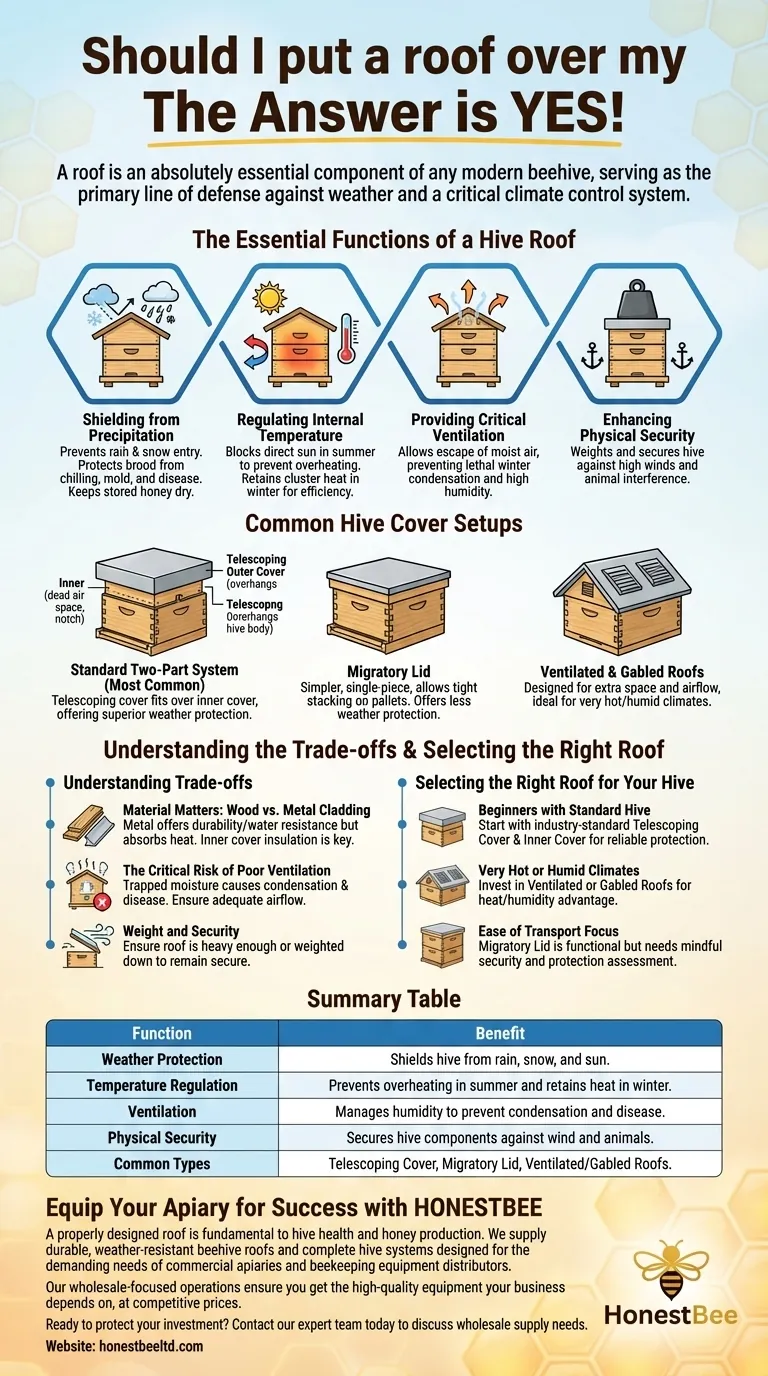
Related Products
- Telescopic Beehive Outer Cover Lid Roof with Galvanised Sheeting for Langstroth Hive and Beehive Outer Cover
- Professional Insulated Winter Hive Wrap for Beekeeping
- Wholesales Dadant Size Wooden Bee Hives for Beekeeping
- Long Langstroth Style Horizontal Top Bar Hive for Wholesale
- HONESTBEE Professional Long Handled Hive Tool with Precision Cutting Blade
People Also Ask
- What are the features of the peaked roof in Langstroth hives? Superior Weather Protection & Stability
- How can garden hive lids be secured to prevent them from being blown off? | Reliable Methods for Apiary Protection
- How do you install the Langstroth hive roof? A Step-by-Step Guide for a Healthy Colony
- What is a telescoping outer cover and what are its advantages? Maximize Hive Protection in Harsh Climates
- What maintenance is recommended for the Langstroth hive roof? Protect Your Hive with Natural Tung Oil








